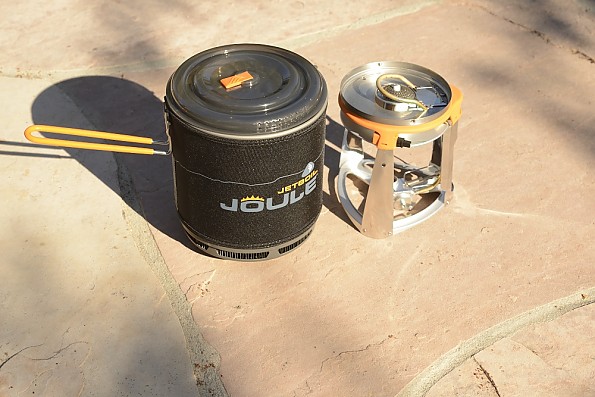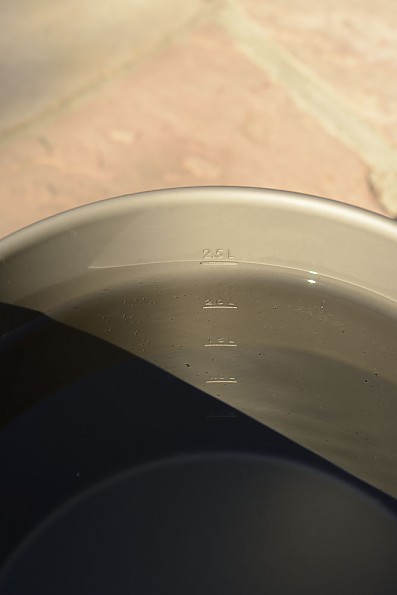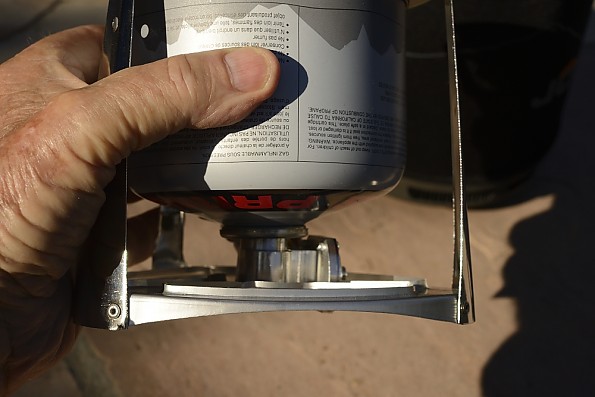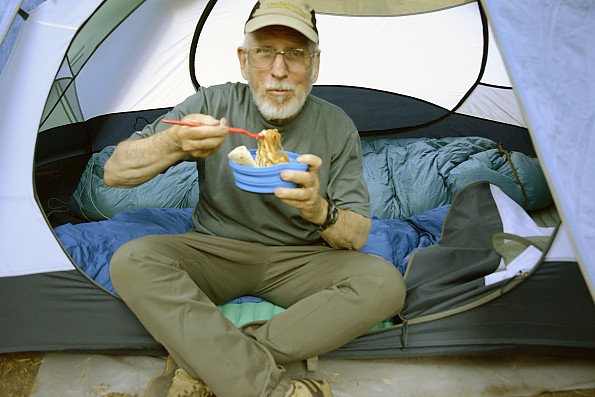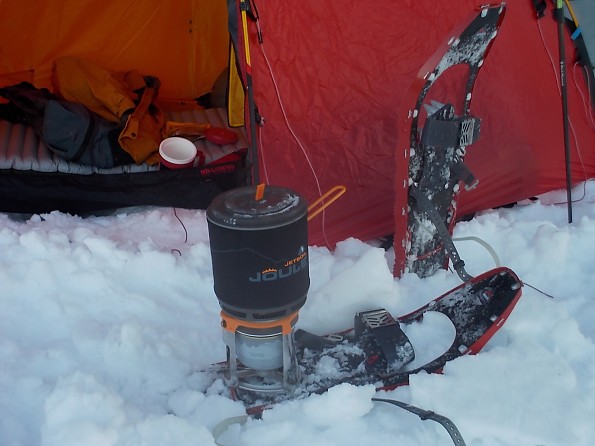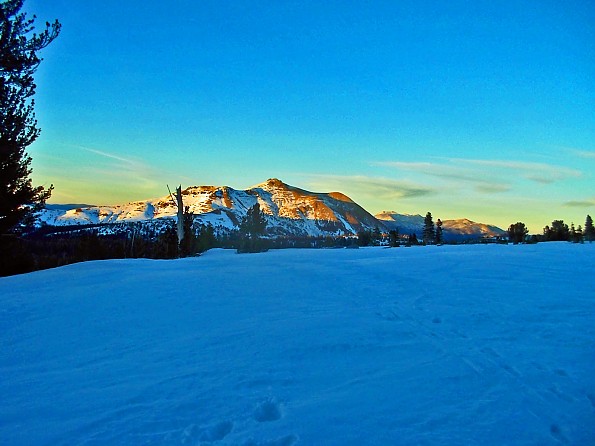Jetboil Joule Group Cooking System

The Jetboil Joule is a canister stove system that is intended for use by “expert backpacking groups and alpinists”, particularly for large groups (four or more). Per my tests, the Joule is best suited for groups of 3 to 5 who are primarily heating water for reconstituting freeze-dry meals, pasta and other 1-pot dishes, and for hot drinks.
The Joule combines several features that expand the capabilities of the stove. The canister is mounted inverted inside the frame base (liquid fuel flow), which helps in colder temperatures. A pressure regulator, an increasingly popular feature of backpacking stoves, helps keep the flame stay constant from a full canister through nearly complete exhaustion.
The increasingly popular integral heat exchanger on the pot improves heat transfer from flame to pot contents. However, as with other JetBoil stoves, the deep 2.5 liter pot combined with the close coupling of the pot and stove limit the usability of the stove for stir fry, pancakes, omelettes, or gourmet cooking .
Pros
- The heat exchanger base and inverted canister mounting provides rapid and efficient heat transfer, which speeds cooking times.
- High heat output (10,000 BTU – higher than many kitchen stoves)
- The pot has clear markings for measuring the right amount of water for making coffee, tea, soups, rehydrating freeze-dry group packets, spaghetti, or other pastas
- Pot lid has drain holes for draining pasta dishes without scalding yourself and acts as an aid for pouring
- Pressure regulator provides constant flame height in a wide range of altitudes and temperature conditions.
- Simmers well
- Packs compactly for a group cooking system.
Cons
- Attaching the fuel canister inside the frame is awkward at best and can result in loss of fuel during the attachment process
- The attached piezo lighter, although convenient, appears to be fragile and subject to early failure.
- Not really suitable for solo or small groups (less than 3)
- Use limited to the supplied 2.5 liter pot
- Takes only the small (100 gram/4 oz) and medium (270 gram/8 oz) canisters (450 gram/16 oz canisters will not fit inside the frame). This means having to carry a large number of the medium canisters on extended trips, and pack out a large number of the empties.
- The Joule is quite loud for a compressed gas stove (within 9 dBA of an MSR XGK-EX expedition stove.
- The foldable handle on the fuel control valve is quite flimsy (the one on the test unit separated several times during the testing)
Note: Because of the drought and high temperatures in California, the test results do not include seriously cold weather or in-snow testing. I will be adding in-snow results as soon as we get cold enough weather and some snow out here in California.
Cold Weather test added: - We finally got some cold weather and snow in the Sierra. So I made a short backpacking trip to run some cold weather updating. The results are added to the end of the write-up.
Caution: Backpacking stoves use fuels that are highly flammable and potentially explosive. Be sure you thoroughly understand the operation of your stove, including fueling. Use the stove only in open, well-ventilated areas that are clear of other flammable materials, such as tents, dry grass, etc. Never use a stove indoors or in a tent (including the vestibule) – the stove flame consumes the oxygen in the air, converting it to carbon dioxide and carbon monoxide. Carbon monoxide is poisonous. Lack of oxygen or excess of carbon dioxide can lead to suffocation.
The Jetboil Joule pot and burner stand
Background: Jetboil has chosen the name Joule for their new “group cooking” stove system. A Joule is the metric system unit of energy, named after the English physicist James Prescott Joule (most derived metric system units are named after scientists who worked on related scientific discoveries). It is the amount of energy or work expended by a force of one newton acting through one meter, or in electricity, one ampere passing through a resistance of one ohm. My guess is that JetBoil thought the name would convey great power.
For detailed discussion of some of the points below, you may want to read my review of the SOTO stove , as well as a discussion from March 2001 that stems from some of the experimenting Jim Shaw and I did, and one on the Primus cold weather kit
Most backpacking stoves are intended for solo use or by groups up to three backpackers and climbers. On expeditions, the larger groups I have gone with resort to using multiple stoves, and almost always stick with liquid fuel stoves, sometimes using several stoves grouped together under large pots (a practice highly discouraged by the stove manufacturers). Several designs of stoves for larger groups have been tried over the years – units with 2 or 3 burners, or on expeditions using pack animals or porters, resorting to large propane tanks to use with multiburner stoves.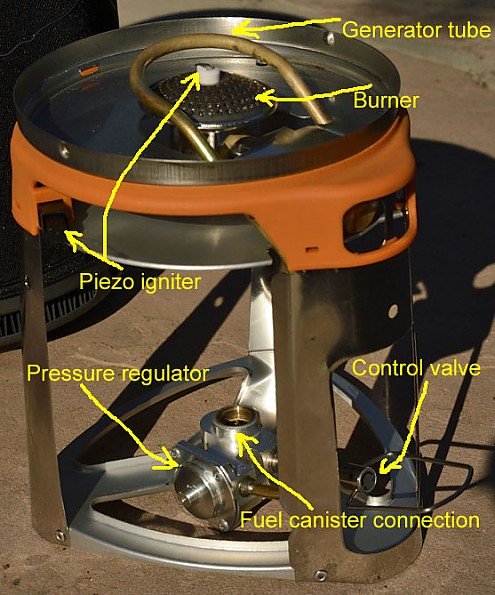
Working parts of the JetBoil Joule
Canister (compressed gas) stoves, while light (for short trips) and compact, suffer a number of limitations when used in conditions that are windy and/or cold, or when preparing meals for more than a couple of people. While compressed gas is convenient, easy to use, and can be used for simmering, the performance suffers substantially in cold temperatures (below 32°F/0°C).
There are several approaches to dealing with the cold weather problem that have been tried over the years. For winter and other cold conditions that large groups go to, the fuel of choice is usually liquid fuels, such as “white gas”. About 20 years ago, Jim Shaw, an engineer who used to appear frequently on the predecessor of Trailspace known as rec.climbing.useful, and I did a number of experiments with heat exchangers, blackening pots, ducting “chimneys”, and inverted canisters, most of which have been adopted by backpacking stove manufacturers in one form or another.
The now popular inverted canister stoves feed the liquefied petroleum gas mixture directly to the burner via the same form of generator tube as used on liquid fuel stoves since the early Primus of the early 20th Century and used by Primus in their early MultiFuelSystem which could be used with compressed gas as well as liquid fuels like kerosene, naptha, and their close relatives diesel and jet fuel.
Among other reasons expeditions tend to prefer liquid fuels, for outings greater than five person-days, liquid fuels along with their larger storage containers and stoves tend to be lighter than compressed gas stoves with their limited size sealed containers, along with the difficulty of estimating the amount of remaining fuel and need to take partially full canisters. With liquid fuels, you only need open the container and peer inside to see the amount of remaining fuel.
I have saved empty canisters in the various sizes and brands to serve as tare weights, then weigh and mark partial containers with their remaining fuel following each trip on an electronic kitchen scale. This does not help in the field, of course. A friend of mine floats his canisters in water and marks the waterline as a crude indicator of remaining fuel. MSR has recently taken to marking the side of their canisters. You simply float the canister in a pot of water and note where the waterline matches the pre-printed marks as a rough indicator of remaining fuel.
Printed Remaining Fuel Levels on a medium MSR canister — float the canister in a pan of water
Although pressure regulators have been used in industrial applications (gas welding, for example), their introduction to liquefied petroleum backpacking stoves is relatively recent, though becoming very popular among canister stove manufacturers.
In the Joule, JetBoil has combined several proven design features to increase the performance of the canister stove – inverted canister with liquid feed through a generator tube (as they introduced to their line with the Helios), heat exchanger integrated into the main pot, and pressure regulator. The canister stand/shroud/control valve assembly provides some wind shielding, though JetBoil offers an optional windshield both separately and as part of the optional alpine kit (the full alpine kit also includes a hanging conversion and specially designed cozy). One thing lacking is a controllable means of transferring some of the flame heat to the canister for use in extremely cold temperatures..
A popular way of comparing backpacking stoves is to compare “boil time” ratings. The “standard” method for determining boil times is to start with 1 liter of water at 20°C/68°F (“room temperature”, also known as the chemist’s STP = Standard Temperature and Pressure). Ideally, the air temperature would also be 20°C with zero wind at sea level air pressure.
While most stove manufacturers do specify the standard 1 full liter of water, some, along with many reviewers writing on the web and in the written press give the time for a half liter (500ml), and do not specify wind conditions or air temperature. Actual boil times achieved by backpackers can vary widely from the idealized number published by the manufacturers because of differing air temperatures, wind, and other factors.
The nominal boiling temperature of pure water is 100°C/212°F. In reality, the temperature of boiling water varies with impurities in the water, atmospheric pressure (lower boil temperature with increasing altitude) and other factors. The pot in which the water is contained also affects the speed with which the water is heated, as does the use or non-use of a lid. With compressed gas stoves, the air temperature affects the pressure of the vapor reaching the burner, with the rate also depending on the ambient air pressure (the reason that canister stoves work well at Himalayan altitudes at subfreezing temperatures that render them useless at lower altitudes).
As the fuel in the canister (a liquefied mix of butane, isobutane, and propane) decreases, the pressure of the vapor decreases as well, due to vaporization of the liquefied gas and resultant cooling of the fuel in the canister. Manufacturers determine boil times starting each run with a new, full canister, as opposed to the backpacker or climber cooking on a mostly depleted canister. The different ratios of the component gases in the canister also affect the rate at which the fuel is sent to the burner. Thus, published boil times are difficult to compare with what you get in the field.
In this case, I did my usual series of boil time tests, starting with 1 liter of water at STP (20°C/68°F, basically “room” temperature) in calm conditions. This included multiple repeats with one liter continuing from a full canister to complete exhaustion. This allows an actual measurement of the number of liters that can be heated on a canister and the fuel consumption rate.
I should note here that several canister manufacturers and several stove manufacturers claim that their combined stove/canister provides 1 hour to 2 hours of burn time. In most cases, I have found that the burn time at full flame is slightly under one hour. When the stove is capable of simmering (most canister stoves are), the burn time will be longer. But the majority of backcountry cooking is boiling water for hot drinks and rehydrating freeze-dry dinners, hence the 1-hour burn time is most encountered in practice.
Since large groups usually will be heating more than a single liter of water at a time, I then went on to getting a boil time for the full pot (up to the highest fill mark inside the pot of 2.5 liters). This test is intended to determine whether the larger pot with more surface area is going to lose heat, or whether the design and cozy are efficient enough to minimize heat loss. Ideally, if it takes 3 min to boil 1 liter, it should take 2.5 times as long to boil 2.5 liters, or 7.5 min. (My criterion for “boiling” is a full, rolling boil, not just bubbling). Less efficiency results in loss of heat (and wasted fuel), hence longer boil times.
Since the Joule uses canisters filled with a mixture of petroleum gases, I must point out that comparison of stoves involves: 1. Differing mixtures of butane, isobutane, propane, and occasionally other related gases; and 2. The amount of gas in a fresh canister varies from company to company for each of the nominal sizes (in other words, a nominally 8 oz canister varies from company to company).
At the 2014 Summer Outdoor Retailer Show, I had a long talk with the head of Primus’s stove division. Primus currently uses three different mixtures of the three main gases to match the location in which the canister will be used (their “deep winter” mix is not currently available in the USA, though I recently received an email from Primus saying they intend to make the deep winter mix available in North America soon). MSR, JetBoil, and other companies also have different mixtures, as do the SE Asian and Slovenian companies. In other words, be a bit skeptical when reading claimed boil times and canister durations..
Since this is a review of a stove, I need to quote from a well-known climber, Clyde Soles, who has used, reviewed, and tested many a stove – “Treat all stoves like the barely controlled explosions they are.” I have personally witnessed explosions and other dangerous incidents with backpacking stoves that involved very experienced backpackers and mountaineers, as well as beginners. Know your stove and treat it with respect.
Details: When Trailspace’s Chief of Gear Reviews, Seth, was looking for someone to test the JetBoil Joule group cooking system, I volunteered to see whether a group system could avoid some of the problems that standard backpacking stoves have when trying to cook meals or melt snow for larger groups. Originally, the stove was to reach me in late Spring 2014. The Man in Brown finally rang my doorbell in late August (delays in receiving test gear are common – the companies prefer to get gear into the retail chain so they can sell them – the JetBoil website at this writing is indicating that the Joule is out of stock and will be available “June 16, 2014”, although my neighborhood REI does have one on the shelf).
On opening the box, I found the stove system packaged in a shaped hard plastic shell that was stapled together around the edges. While this protects the gear (I have received some gear that was packaged in flimsy material), it did make for a challenge to get the six burley staples removed.
Inside I found a cardboard insert that made several performance claims, the 2.5 liter pot with heat exchanger and neoprene cozy, burner/shroud/stand assembly, cloth bag to hold the burner assembly when stored inside the pot, and strainer lid, along with the sheet containing instructions and cautions in 16 languages, of which I can read 4, plus struggle with one more (I can read more languages than I can speak or understand when spoken to me). It is always amusing to compare the multiple sets of instructions and especially the often widely differing warranty and guarantee sections.
Water Level Markings inside the Joule Pot
The pot has marks inside every half-liter to make measuring the amount of liquid needed for a freezedry packet, for example, easy to determine. As is common these days, the stove has a piezo lighter. While piezo lighters are convenient, they have gained a reputation for failing (often by breaking) fairly quickly. The Joule’s piezo struck me as being on the fragile side, though it has held up well so far and has been dependable in lighting. A supply of matches or a lighter is a recommended backup for the Joule or any other stove. As the video shows, the stove does tend to light with a noticeable “POP!”
The Pot Lid has holes for draining water from pasta and to aid in directed pouring
The lid for the pot has series of holes intended for draining the cooking water from, for example, cooking spaghetti, as seen in the nearby photo. It also aids in pouring. This did present me with a puzzle, however. If I have cooked the spaghetti until it is al dente, then drain the water, how do I now prepare my family’s Secret Backcountry Spaghetti Sauce? I clearly need to carry a second pot for preparing the sauce, mix the sauce into the spaghetti, or perhaps carry a bag of pre-grated parmesan or other cheese. However, standard backpacking cook kit pots will not sit on the Joule’s stand, due to not being able to clear the burner or generator tube. This also precludes using a fry pan, wok, or other cooking containers.
I then weighed the various pieces of the stove system. The burner and shroud assembly can only accept standard small 100 gram and medium 250 gram canisters – the large 450 gram canisters will not fit. I have included 2 popular canisters for comparison.
Table of weights:
JetBoil 2.5 liter pot with heat exchanger – 397 g/14 oz
Strainer lid – 57 g/2 oz
Burner, shroud, and valve assembly – 331 g/11-5/8 oz
Soft bag – 26 g/7/8 oz
Packed system – 812 g/1 p 12-5/8 oz
Full MSR IsoPro fuel canister – 358 g/12-5/8 oz (225 g/8 oz nominal fuel)
Full Primus Powergas – 375 g/13-1/8 oz (230g/8.9 oz of fuel)
Testing details: The initial static test setup was on my back patio. I was pleased that the initial 1 liter of water boiled in 2 min 30 sec, slightly beating the claimed 2:35. Throughout the testing, I used the 230 gm/8.9 oz Primus Power Gas canisters. These contain a “4-season” mix of propane, isobutane, and butane, though not the Winter mix that Primus has available in Europe. I find them far better in cold weather than the old pure butane or 70/30 butane/propane mixes we used to get, though not as efficient as MSR’s and Markill’s all-season canisters.
On a side note, while in my neighborhood REI to get some canisters for the testing, I noticed that the Primus 230gm canisters (the mid-size) were $4.95, while the JetBoil 100 gm canisters (smallest available) were the same price or 2.3 times as expensive per ounce of fuel. Yeah, I know, the tiny canisters are nice and light. But, in addition to being more than twice the cost per amount of fuel, you have to carry the empties out (here in Palo Alto, we recycle the compressed gas canisters in the regular “Blue” recycle bin, if you puncture them first, perhaps using JetBoil’s CrunchIt , otherwise take them to the monthly hazardous waste day).
The 500 gm canisters (largest size normally available) are harder to find, but are cheaper per ounce/gram of fuel, although as mentioned, they do not fit the JetBoil Joule. This to me is quite curious, given that the Joule is described by JetBoil as being intended for groups (up to five) and for expeditions.
My fuel consumption rate and “liters boiled” tests were very consistent with the basic rule of thumb of 2 ounces (weight) of fuel per person-day, if the stove use is for hot drinks and rehydrating freezedry meals. For a group of five, this means using 1.25 mid-size canisters per day on average during 3-season trips. Thus a typical hike of the John Muir Trail (220 miles, 20 days including some peak bagging) would require 25 canisters. The 25 empty canisters to be carried out weigh 3.75 kg/ 8.25 pounds.
Similarly, a week-long backcountry climbing trip with five friends would require nine canisters. Remember, those empties must be packed out. A typical empty midsize canister weighs 150 grams, making the climbers carry out 1.3 kg/3 pounds of metal. I should note that the canisters of a given nominal capacity do not all weigh the same when empty (depending on the company and when they were filled), though the variation is small.
Attaching the fuel canister inside the stand/burner cage is a bit awkward
Attaching a medium canister to the JetBoil Joule is a bit awkward, due to the minimal spacing to place the canister inside the frame. The crowding also causes a bit of a problem in threading the canister rapidly to minimize the leakage of the gas before the canister is fully seated on the gasket.
Removing the canister similarly is a bit awkward and results in a slight amount of gas leakage in the process. I have not had this much leakage in mounting or removing full or partial canisters with my JetBoil Helios, nor with my MSR, Primus, Vaude, or SOTO canister stoves. I did find that the amount of fuel leakage in attaching and detaching the canister is lessened by inverting the stand and attaching the canister in the “upright” orientation (in the inverted operational orientation, the leakage is of liquefied fuel, while in the “upright canister” orientation, the leakage is of the gaseous vapor).
Since the stand can be stored inside the pot with the canister mounted, I would suggest leaving the canister mounted from the time you mount a new full canister until it is exhausted. This problem also means that it is ABSOLUTELY IMPERATIVE TO OBSERVE JETBOIL’S DIRECTIVE TO ATTACH AND REMOVE CANISTERS AND USE THE STOVE OUTDOORS IN A WELL-VENTILATED AREA. This applies to all backpacking stoves, not just the Joule.
Remember, the fuel is explosive and the stove should be well removed from any open flames and never used indoors or in any tent or snow cave, due both to the danger of fire and carbon monoxide. [NOTE: JetBoil includes a strong statement concerning CO emissions from the stove. At this point I have no data on the amount of CO emission from the Joule, but will point out that this is a well-known and widely publicized aspect of camp stove usage for all fuels].
Another flaw I discovered in usage was that the fold-out wire on the flame control valve is easy to dislodge. Reinserting it into the hole on the spindle was easy enough with the needle-nose pliers on my pocket multi-tool. This would be a bit of a nuisance if I were in the midst of cooking and ready to shut the stove down. I have several other stoves with a similar design (JetBoil Helios, SOTO, Markill, Vaude) and have never encountered that problem with any of the others.
The heat exchanger on the bottom of the pot has several slots positioned to be able to lock the pot to the burner assembly, providing extra stability. JetBoil uses the name FluxRing with a trademark or registered symbol next to it on various members of the JetBoil family of stoves. The design is very similar to attached heat exchangers used by several other companies.
The 1 liter boil time test series was carried out on my back patio at an air temperature of 73°F, but the water starting at 70°F. Wind speed was calm and the stove location was shaded (not direct sunlight). The time for one liter to a full rolling boil was consistently between 2:27 and 2:33 minutes, slightly faster than the specification on the JetBoil website. The “bubbling” level that many of my hiking companions call “boiling” was generally reached at 2:15 min.
Fuel consumption averaged a rate of 4.1 grams/minute both for the 1 liter tests and for the full pot 2.5 liter tests (boil time for 2.5 liters was 5:40, almost exactly 2.5 times the median 2:30 one liter boil time. In the 2.5 liter tests, I found it necessary to be very quick in shutting down the stove or removing the pot from the stand, due to the vigor of the full rolling boil at the maximum fuel flow setting. This works out to about 22 to 24 liters boiled on a medium canister.
While bench-testing in town can reveal a lot about a stove, at Trailspace, we always test gear in the field in as wide a range of real backpacking and climbing conditions as possible. If Nature does not cooperate during available test time (such as the current extended drought and hot, dry weather we are experiencing on the West Coast), we follow up during trips to other climes or later in other seasons. Given the current drought, I will be following up with tests in winter conditions in one or more winter snow areas where I can go backcountry skiing.
Cooking Spaghetti in the Hills
Fuel consumption: Fuel canister manufacturers claim that the mid-size canisters will last from 1 to 2 hours. Obviously, this depends on whether you are running the stove at simmering or at maximum. Most of my uses of the stove during testing were timing a full boil in various conditions in the local mountains (I am a volunteer adult Boy Scout Leader and camp at one of our two camp properties fairly frequently) and several locations in the Sierra Nevada backpacking and during American Alpine Club climbing events.
The pressure regulator is intended to keep the flame at a constant rate (or nearly so, since the gas pressure at the burner also depends on the temperature of the fuel and amount remaining.). At maximum flame setting, a medium (8 oz/230 gm) canister will last 59 minutes, based on the fuel consumption rate measured during the boil tests. For lower flame settings (simmering, cooking pasta to the al dente state), duration can be up to 2 hours.
Sound level: A concern for many backpackers and climbers is the noise level of stoves. Most liquid fuel stoves, particularly those with “roarer” burners, have sound levels in the 80-90 dBA range, leading to descriptions such as “747 takeoff” and “launch the Shuttle” (OSHA standards recommend wearing ear protection at that level). “Silent” burner stoves typically have sound levels in the 65 to 70 dBA range, much quieter, but hardly “silent”.
Since the burner design of the JetBoil Joule (and other JetBoils as well) is a screen-type “silent” burner, I was more than a little surprised at how loud the Joule was. I measured the sound level using my calibrated sound level meter set up as usual (see my reports on the SOTO stove and the QuietStove burner conversion cap ), The Joule tested out at 76dBA, 10 dBA louder than other silent-burner stoves like the SOTO, MSR Pocket Rocket, and MSR Whisperlite (or 10 times louder than ordinary conversational levels), and 9 dBA quieter than the roarer burner XGK-EX.
Field tests: I used the Joule on several backpacks in the Sierra. Most of the meals were the usual backpacking meals (freeze-dry, soup mixes, hot beverages, boiling to sterilize the water). Other than the larger capacity of the pot and the inability to use a fry pan, standard pot, or wok with the Joule’s burner, there was nothing notable or out of the ordinary about preparing meals on the Joule.
I also tried fitting one of the camp oven devices to the Joule’s burner stand to try out baking, without success, something that can be done with a wide variety of other canister and liquid fuel stoves. In other words, the Joule is like the other stoves in the JetBoil family in being limited to boiling water for melting snow, freezedry, soups, and hot drinks. Given that these are the uses that the majority of backpackers stick with, this may be a minor limitation. Personally, I like to do a bit of “gourmet” cooking, especially on longer trips.
Spaghetti prepared with the JetBoil Joule, topped with our family's Secret Backcountry Spaghetti Sauce - YUM!!!
Conclusions: The Joule is a well-performing stove, giving fast boil times for the majority of backpackers who depend largely on freeze-dry foods, with a fairly efficient use of fuel. For groups in the three to five person category, the Joule fills a need.
While I have not had a chance to test the Joule in cold conditions (due largely to our continuing severe drought in California and closure of many of the mountain areas due to widely spread wildfires), the combination of an inverted canister, pressure regulator, and integral heat exchanger of same design as JetBoil’s Helios and other stoves in their line leads me to expect that the Joule will also perform well in low temperatures.
I have several trips planned to the Sierra and Utah’s Wasatch during the upcoming ski season (I do backcountry ski touring), which should allow testing under those conditions. Look for the addendum in a couple months.
Cold Weather Addendum: After a warm summer and the drought, we finally got some rain in November and finally snow in the Sierra in December. So on December 23-24, I headed up to Carson Pass and snowshoed in to Lake Winnemucca, camping at about 10,000 feet elevation. There was plenty of snow (with an icy crust). The test basically consisted of having the canister in the top pocket of my pack, where it would get cooled on the hike in, then leaving it sitting in the snow while I set up the tent until time for supper. I melted snow (1 kilogram’s worth to get 1 liter of water), let it heat to boiling, then immersed a sealed pack of Tasty Bites (heat in boiling water for 5 minutes). The hot water was then used to refill my 1 liter Nalgene (to provide a hot water bottle to warm the sleeping bag) and make hot drinks. The stove with the attached canister was left in the vestibule overnight to allow the canister temperature to adjust to the overnight low temperatures in the low 20°F/-5°C range. Since butane (the major ingredient in the compressed gas canisters), I expected to see some drop-off in performance.
The picture shows the “kitchen setup” with the Joule sitting on a snowshoe outside the tent (tents have been known to catch fire, and I did not want to chance that, being solo several miles from the nearest road, no one else out there with me). You might worry about the possibility of damage to the neoprene decking on the snowshoe. In the earlier tests, I had touched and handled the stove stand during cooking and found it remained cool to the touch. Another reason for having the stove outside is the known production of carbon monoxide (CO) and oxygen depletion in enclosed areas. Plus I wanted to see about any possible effects of having the stove and pot exposed to the cold air (JetBoil’s neoprene cozy is claimed to provide insulation).
In the morning, about an hour pre-dawn, I prepared breakfast, again melting enough snow to provide a liter of water. When melting snow (or ice), always put a small amount of water in the bottom of the pot to prevent scorching the pot, so technically, there was about 50 cc less than a kg in snow. Stirring the mix also helps prevent scorching. I used clean snow, of which there was plenty (including the icy crust).
Now for a little basic physics – in the earlier tests, I was boiling 1 liter of water, starting at “room temperature”, which is 20°C (about 70°F). Since boiling is 100°C, the temperature has to be raised by 80°C. Adding 1 calorie to 1 gram of water increases its temperature by 1°C . That means it takes 80 kcalories to raise 1 liter of water (which has a mass of 1kilogram, about a quart) from “room temperature” to boiling.
But we are starting with snow and ice, which is at 0°C and thus frozen. We have to melt it first, which takes 80 kcal per liter (1 kilogram of ice) to melt it from ice to water, still at 0°C. Now we have to heat the just melted water by 100°C to get it to boiling, or 180kcal total (80kcal to melt the snow plus 100kcal to heat the cold water up to 100°C) to get that kilogram of snow and ice up to boiling. That’s 2.25 times as much heat as taking room temperature water up to boiling. And in winter, you are losing a lot of heat to the surrounding air. So this is a test of the Joule’s insulating cozy plus breeze resistance, plus loss of pressure due to trying to vaporize a gas mixture that has lots of butane, which doesn’t vaporize below about freezing (0°C/32°F). That’s demanding a lot of the stove.
Already having a heavy load in my pack (tent, sleeping bag and pads, spare winter-weight clothes, snowshoes on my feet, winter boots, camera, food, etc), I did not bring a tripod for the camera (sorry, no videos), nor did I bring a scale to measure fuel consumption. But I did get total fuel consumption for the trip.
In the original test, I found that the Joule burns an average of about 4 grams of fuel a minute, or 10 grams of fuel per liter of water boiled. Thus, I would expect that melting a kilogram of ice or snow to get 1 liter/quart of water and continue up to boiling would take 22.5 grams of fuel. Thus 2 meals should, in principle, take 45 grams of fuel. But I also heated the Tasty Bites packet by boiling it for 5 minutes (that was their Madras Lentils – very tasty!), or another 20 grams of fuel for a total of 65 grams. The actual amount burned for the 2 meals prepared was 67 grams, well within the probable error.
My conclusion for the Joule’s cold weather performance was that the combination of the inverted canister (which provides a liquid fuel feed) and the proximity of the canister to the burner (with reflection of heat back down onto the canister) provides good cold weather performance, at least in the 20°F range.
The frame of the stove stand provides enough isolation that the stove can be set on the neoprene snowshoe webbing (or probably a closed cell foam pad). The neoprene cozy on the Joule’s pot does seem to improve the efficiency somewhat, though the weather was not cold enough to get a good handle on that.
The downside is that, when carrying winter gear (which is significantly heavier than a summer pack), the weight of the Joule (almost 2 pounds plus the needed fuel canisters) demands using it only when you have a group to share the load. I was cooking for 1 person, but using 2.25 times as much fuel to melt the snow and heat it to boiling as in the warm weather situation. Thus while in 3-season weather, a medium canister supplies about 4 person-days of fuel (1/4 canister per day per person), adding the extra fuel needed for melting snow, means you will use over half of a canister per person-day.
Given the variability in people’s personal cooking styles and practices, you will need to keep close track of your own usage to be able to plan cold weather usage for your own conditions. My personal experience on expeditions has been that while 2 ounces (weight) per person-day of petroleum fuels (liquid fuels like white gas or compressed gases like butane mixes) is a good basic number for 3-season camping, in very cold conditions (for example, on Denali or in Antarctica with temperatures lower than 0°F/-18°C), melting snow or ice for water boosts consumption to 8 ounces per person day or more.
Source: received for testing via the Trailspace Review Corps
(Sample provided by Jetboil for testing and review)
This is my third Jetboil stove and I literally damaged it simply setting it up. The two back stand supports are extremely flimsy. I bent one holding the stove in my hand while inserting the gas canister. I will wait until I hear a reply from Jetboil before I decide what to do with the stove.
Cons
- The gas canister is difficult to install with bare hands, much less gloves.
- The metal stove supports are extremely flimsy in the rear and they are sharp if you are not using gloves.
I received a Jetboil Joule as a birthday present. I have had two different Jetboil stoves in the past and was exited to use a newer and larger version. This one is advertised as being wonderful to use in temps down into the negative numbers.
The first thing that I noticed was that the pot and stand were not connecting smoothly. I chalked this up to it never being used before.
The second thing that I noticed was that the gas cartridge is not easy to install. There is zero clearance and you have to slowly work it into place. The canister also contacts the piezoelectric spark wire as you are installing it, which can't be great for long-term durability.
Not immediately apparent is the fact that the metal rear supports are extremely flimsy and relatively sharp, especially at the top of the support. This also happens to be where a gently held the stove when I tried to install the gas cartridge.
I'm astonished that a stove that is being marketed as a "winter" stove for groups is easily damaged at home under controlled conditions using my bare hands.
Background
My experience with other stove models from Jetboil have always been positive. This is the first one that I have had serious reservations with using.
Source: received it as a personal gift
Your Review
Where to Buy
You May Like
The Joule Group Cooking System replaced the Jetboil Group Cooking System (GCS).
Specs
| Price |
MSRP: $199.95 Historic Range: $19.95-$199.95 |
| Fuel |
propane/isobutane, Jetpower |
| Boil time for 1 L of water |
2:40 |
| Water boiled per 230 g fuel |
24 liters |
| Weight |
28 oz / 790 g |


